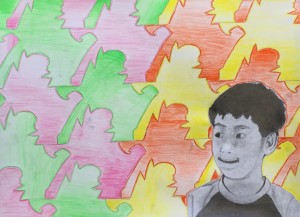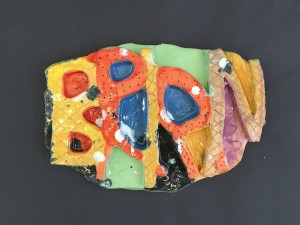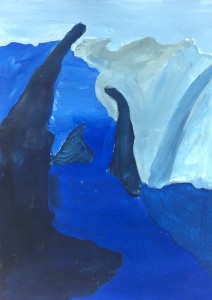Perspective Drawing
Brian Lin
In this summative assessment, we were instructed to design a one-point perspective or two-point perspective city after some practices of perspective letters. Compare and contrasting one-point perspective and two-point perspective would be that both designs are drawn for viewers to see in a perspective that fits real life. Both are designed to start with a horizon line and vanishing point(s), and drawn in eye levels: above, on, below. The difference would be the amount of vanishing point(s), for one-point perspective there is 1 vanishing point, for two-point perspective there are obviously 2 vanishing points. Vanishing point is the point at which receding parallel lines viewed in perspective appear to converge, in simple that is something that has been growing smaller or increasingly faint disappears altogether when you examine it. I chose one-point perspective in this summative assessment because it happens more often in my real life I predict what I draw will be more realistic than drawing two-point perspective city.
I started my city obviously by drawing my horizon line and vanishing point, and it kind of goes in a pattern, because mostly everything goes towards the vanishing point other than horizontal and vertical lines which are either parallel to the horizon line or perpendicular as it is a vertical line. My first object in my city is a road, 2 lines, endpoints are on the vanishing point, then finishing off the road with shorter but thicker lines in the middle, that divides the road up into two parts as in real life is. Obviously, the lines has to go towards the vanishing point too. At this point of drawing, I’ve acknowledged one thing: as lines are closer to the vanishing point, it becomes smaller, and lines that are further away, are larger. For example in my sidewalk bricks, the spaces between each brick gets smaller as it goes towards the vanishing point, in real life, it is too! Huge buildings eventually gets smaller as you move further away from it, not actually getting smaller, but from one’s eye level perspective, it does.
I demonstrated different shapes too, in my perspective drawing city to show that I could perform one-point perspective not only just with straight lines, with arcs, circles, even curved prisms too! In fact, my objects all showed quality in space because it matches up real life, the proportions of ratio in different objects doesn’t have much difference, which makes the city more realistic. My artwork doesn’t include any color, but value, value by pencil. In perspective drawing, it is like 3D objects that people see. Object that has faces, I demonstrated and showed different faces by coloring different values for different faces. Emphasising the lines will be more easy for the viewers to know what you are drawing and not get confused. I somehow showed balance in different objects I drew, so it looks realistic. It the drawing in perspective art is not balanced, no matter how accurate you draw, it doesn’t seem realistic.
Overall in this summative assessment, I think perspective art is really cool, it’s like when you see something in real life and drew it out on the paper with the same perspective. Every detail shows unity, creativity, and harmony. Of course, movement is the largest part or perspective art, my artwork demonstrates movement by objects and angles, every single line and details. To conclude my artwork, the objects I drew includes road, mountains, buildings, letters, fence, train, and railway.
Comparing my work to others, in my work I demonstrated less lines than my peers, but more presented in more details, in my peer’s work, he demonstrated a solid knowledge of creating buildings and the concept of lines to vanishing points, more in detail, he understand what line goes under or above another line. Shapes in my artwork is demonstrated in a variety of ways, while my peer’s artwork only demonstrate prism like shapes. I included in curved prisms, rectangular prisms, cylinders; in different sizes. Somehow I think I demonstrated more in space by including 4 roads with 3 different directions. However, my peer did good too by making the road big and clear while it is a two-point perspective. Color didn’t really affect how one looks at my artwork, because the lines are well measured with precision. However, my peer colored in his artwork so it looks more line one. Overall, I demonstrated more in value with my pencil while my peer colored in fully. With just one color; my pencil, I have to demonstrate good value to divide up different sides so it looks 3D.


